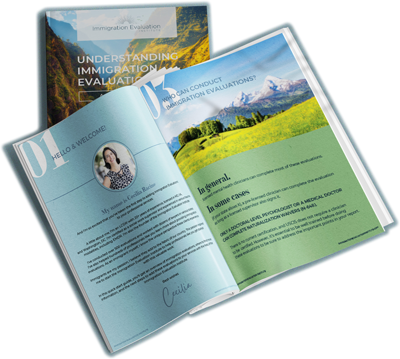What do you want to learn more about?
Domestic Violence Awareness Month: Understanding a Complex Issue within Our Communities & Immigration

Calls to emergency services regarding domestic violence have risen steeply during the COVID-19 pandemic, with some researchers dubbing it a “pandemic within a pandemic.”
When victims already feel trapped, it’s worth noting that domestic violence can be doubly impactful on the migrant community, where individuals are already separated from their families by borders. Without the ability to leave and with no one nearby to seek safety with, migrants can suffer exponentially.
Understanding Domestic Violence
Domestic violence, also referred to as domestic abuse or intimate partner violence, has existed for centuries and has typically been understood as a male on female form of violence.
According to the United Nations, domestic abuse is: “typically manifested as a pattern of abusive behavior toward an intimate partner in a dating or family relationship, where the abuser exerts power and control over the victim.”
Anyone can be a victim of domestic violence, regardless of age, race, gender, sexual orientation, faith, or class. Domestic violence can involve other individuals within a household, including children, vulnerable adults, or elderly parents.
Domestic abuse can be mental, physical, economic, or sexual. Incidents are rarely isolated and usually escalate in severity. Domestic violence may culminate in serious physical injury or death.
What is National Domestic Violence Awareness Month?
October was first declared as National Domestic Violence Awareness Month (NDVM) across the US in 1989. Since then, October has been a chance to acknowledge domestic violence survivors and voice its victims.
According to the dedicated NDVM website: “The devastating consequences of domestic violence can cross generations and last a lifetime. Although there has been substantial progress in reducing domestic violence, an average of 20 people is physically abused by intimate partners every minute.”
This equates to:
- More than 10 million abuse victims annually.
- 1 in 3 women has been physically abused by an intimate partner.
- 1 in 4 men has been physically abused by an intimate partner.
- 1 in 5 women has been severely physically abused by an intimate partner.
- 1 in 7 men has been severely physically abused by an intimate partner.
Being aware that domestic violence happens simply isn’t enough. October is an opportunity to focus on education and awareness and raise our standards as therapists and community members to support the most vulnerable in proactive ways.
Domestic Violence: A Genderless Crime?
Reading through those statistics above, did any of them surprise you?
In particular, I’m wondering if the number of male victims of domestic violence surprised you?
I was under the impression that domestic violence was a crime acted out by men against women for the longest time. It was something husbands did to their wives to control and manipulate them and assert their dominance within the household.
As our understanding of domestic violence and domestic abuse has expanded, so has our understanding of ‘who’ the victims are, as well as ‘who’ the perpetrators are.
Domestic Violence Against Men
Research and data on domestic violence against men have emerged, and the acknowledgment that men can also be victims opens up new dialogues around this sensitive and traumatizing subject.
UK-based charity, ManKind Initiative, which aims to help men experiencing domestic violence, has conducted several reports, with recent findings:
- 1 in 6 men and 1 in 4 women will be victims of domestic abuse in their lifetime.
- Of domestic abuse crimes recorded by the police, 26% were committed against men.
- Over the pandemic period, the charity saw an increase of calls to its helpline by one quarter and visits to its website by 75%.
- 61% of the men who call the ManKind Initiative helpline have never spoken to anyone before about the abuse they are suffering.
- 64% would not have called if the helpline was not anonymous.
- Half of male victims (49%) fail to tell anyone they are a victim of domestic abuse and are two and a half times less likely to tell anyone than female victims (19%).
- 11% of male victims have considered taking their life due to partner abuse. The charity has seen an increase in calls regarding suicide ideation over the pandemic period.
- Over the past five years (April 2015 to March 20), on average 12 men per year had been killed by a partner or ex-partner (74 women per year).
One thing the ManKind Initiative doesn’t seem to have reported on (yet) is whether the men reporting domestic violence are in heterosexual relationships or the cultural backgrounds of men who report being victims of domestic violence.
These factors play a significant role in whether an individual would choose to report experiencing domestic violence and could mean that these figures (just like the figures for female victims) are only a small piece of the wider picture.
Our Role as Therapists
I know many therapists who deal with domestic violence victims and perpetrators in the course of their practice. Therapy is a vital tool for both parties in understanding, processing, and moving past their experiences to a healthier version of who they want to be.
Within immigration evaluations, knowing how and when domestic violence may show up and the signs to look out for could make the difference in how you ultimately support a client.
Domestic violence can show up as an abuse of power, control, and manipulation with clients applying for visas while in relationships with a US citizen or Lawful Permanent Resident. Some things to look out for could include:
- Emotional abuse or blackmail: For example, if the abuser lied to the victim about their immigration status or called them racist names.
- Economic abuse: For example, forcing a victim to work illegally, sign legal documents in a language they do not understand, or control their finances.
- Coercion and threats: For example, threatening to revoke immigration support, report family members to immigration, or have the individual deported.
- Manipulation over children: For example, threatening to have the individual deported without their children or using custody battles to maintain control or manipulate them.
- Meddling with their application: For example, destroying or withholding important documents, lying about submitting applications or documents, or refusing to sign/confirm documents.
The Violence Against Women Act (VAWA)
In our role as immigration evaluation therapists, one thing worth knowing is the Violence Against Women Act (VAWA). The VAWA supports comprehensive, cost-effective responses to domestic violence, sexual assault, dating violence, and stalking.
Since its enactment, VAWA programs, administered by the U.S. Departments of Justice (DOJ) and Health and Human Services (HHS), have dramatically improved federal, tribal, state, and local responses to these crimes.
An immigrant client (of any gender) married to a US citizen, or Lawful Permanent Resident who has suffered domestic abuse may be eligible for immigration relief under the VAWA. By doing so, they self-petition for lawful status in the United States, separate from the perpetrator of the abuse.
If successful in their application, the victim will receive employment authorization, access public benefits, and become eligible to apply for lawful permanent residency status. It can also protect non-citizen victims of domestic abuse from being deported by canceling ongoing removal proceedings and granting the victim legal permanent residency status.
National Domestic Violence Month: An Opportunity
The impact and trauma of domestic violence can be felt for a lifetime for victims, especially for those who never get a chance to have a voice or receive appropriate support.
In a state of isolation, removed from family, with no ability to return to them, migrants experiencing domestic violence may feel helpless and without hope.
We can use this month to keep educating ourselves, our communities and working with our clients to let them know we’re here for them and that support is available.
Use this month to connect with those around you, especially those you might already be concerned about – let them know they are not alone.
I’ll leave you with you excellent resources to keep raising awareness:
- The Hotline: National Domestic Violence Hotline (for men and women).
- Identify Abuse: Recognizing abuse is the first step (for men and women).
- National Coalition Against Domestic Violence (for men and women)
- Report: How Coronavirus Is Affecting Victims of Domestic Violence
- National Hotlines – Victim Connect Resource Center (for men and women)
- Get help: Office on Women’s Health

I’m Cecilia Racine, and I teach therapists how to help immigrants through my online courses. As a bilingual immigrant myself, I know the unique perspective that these clients are experiencing. I’ve conducted over 500 evaluations and work with dozens of lawyers in various states. Immigrants are my passion, I believe they add to the fabric of our country.
related articles
Helping Immigrants Find Safety and Healing Through U and T Visas
As mental health clinicians, we possess a unique set of skills that can be a…
Expand Your Expertise: Recommended Trainings for Immigration Clinicians
The Immigration Evaluation Institute Comprehensive course is a great first step into the world of…
Ethical Considerations in Immigration Evaluations
The role of mental health professionals in immigration evaluations is fraught with unique ethical complexities.…
Join the Free
Immigration evaluation
therapists facebook group
Are you a therapist that conducts immigration evaluations?



